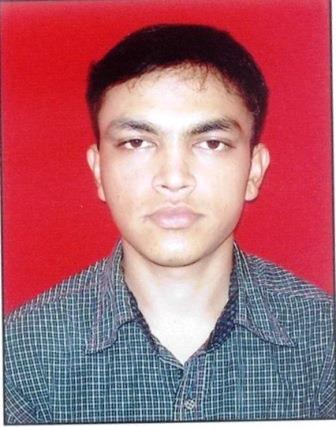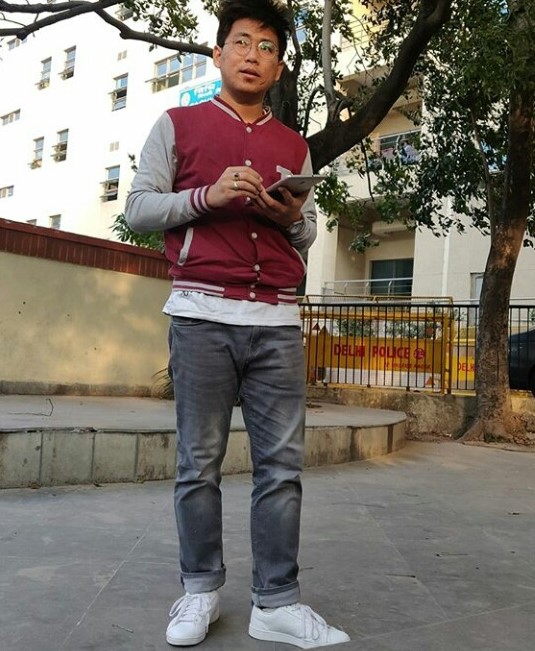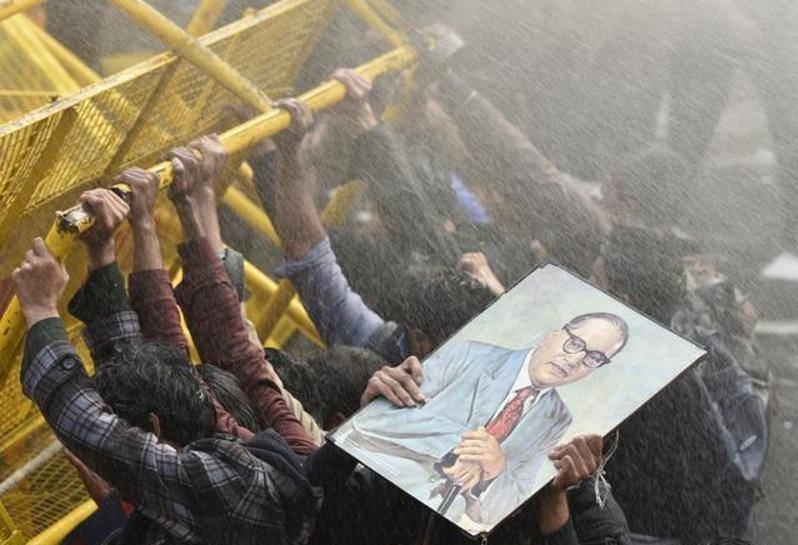Vidyanand Thombare
 Love has universal value. It’s eternal and thus doesn’t recognise any boundaries that our social structure tries to impose on it – it exists beyond all boundaries. This universality has been widely expressed in many forms, especially through films in our society. In India, cinema and cricket are two religions on their own, apart from all the other religions. Almost every year, more than two hundred Bollywood films are released in India. Yet, it’s a rare exception to find a movie which is not based on heterosexual love relationships. Every Indian movie plot revolves around the love between hero and heroine, who face some resistance to their love. Finally, they fight and succeed in getting rid of the hindrance. These movies contain a lot of emotions and dialogues that impact many. In this scenario, Nagraj Manjule’s recent Marathi release, Sairat has become a benchmark in itself.
Love has universal value. It’s eternal and thus doesn’t recognise any boundaries that our social structure tries to impose on it – it exists beyond all boundaries. This universality has been widely expressed in many forms, especially through films in our society. In India, cinema and cricket are two religions on their own, apart from all the other religions. Almost every year, more than two hundred Bollywood films are released in India. Yet, it’s a rare exception to find a movie which is not based on heterosexual love relationships. Every Indian movie plot revolves around the love between hero and heroine, who face some resistance to their love. Finally, they fight and succeed in getting rid of the hindrance. These movies contain a lot of emotions and dialogues that impact many. In this scenario, Nagraj Manjule’s recent Marathi release, Sairat has become a benchmark in itself.
Sairat also depicts a love story, with a hero and heroine. Yet what makes it a benchmark is the fact that this is the only movie so far that has broken many traditional stereotypes. Usually, heroes and heroines are mostly familiar faces to us – most new introductions come either from a lineage of big Bollywood families or are sons and daughters of big businessmen or established politicians. There are very few good actors who manage to enter this industry with lot of struggle and they have to pass through the toughest challenges of acting, auditions etc., to get selected. Even after that, they hardly have any choice when it comes to getting a role that can do justice to their talent. Sairat is a benchmark, since both the lead actors and most of the supporting cast were not familiar faces. Neither were they from a lineage of patronage, nor were they actors. They were faces from the streets of Maharashtra that never had any thought of acting. It was only the suitability of their appearance, attitude or personality from the viewpoint of director Nagraj, that got them selected for the lead roles. This is in fact a good approach – it breaks the tradition of fake artistes (in fact non-actors) who somehow create a brand image, do everything to maintain their brand and take a larger share of the movie income. Nagaraj on the other hand selected actors from the street, saved money, and utilized it for aspects that were important for the movie, such as the background score. Would they (Nagraj and the producers, Nitin Keni and Nikhil Sane) have managed to record at Sony Symphony Studio in Hollywood if the lead actor in their film demanded a larger share of their spending?
Secondly, in almost all movies, the lead actresses are stereotyped, with a ’36-24-36′ body, attractive looks, and fair complexion. Sairat not only breaks this well-accepted norm but also presents a dashing and bold performance from Archi (Rinku Rajguru), that makes audiences accept her in a way beyond what popular actresses experience. In contrast to them, Archi is somewhat plump who is not that fair, and with a commonly found face. Films impact and often force many to go for zero figure. We are aware of upper class girls’ efforts to groom themselves – diets, exercise etc., which are inaccessible to traditional rural girls. This impacts rural lower-caste girls, mostly by creating feelings of inferiority. A film like Sairat conveys to them that what is within you matters more than any outward appearance – a truly empowering step towards gender sensitization and women’s empowerment.
Thirdly, the movie does not have any dialogues that are not part of our day-to-day life. Nagraj was successful in picking the exact words from the everyday conversations of people. The words and language in the movie are very simple and commonly spoken in western Maharashtra. Unlike most other movie scenes of proposal for love, this movie portrays it in a very simple language:
“Mala Kharach vatana, mi itha aalo aani tu mahyasanga bolati te”.
(I just can’t believe it, that you are here and talking to me)
“Tyat Khara nahi vatyay kay zala, Mi Kharach aali.”
(What’s not to believe in it? I am here …really)
“Arche! Mala tu Lai Awadati.”
(Arche! I like you the most)
“Mala pan tu lai awadato.”
(I too like you the most)
“Marathit Sangitlela kalat nahi? English madhe sangu”- “I love you.”
(Don’t you get it in Marathi? Shall I tell you in English – I love you)
Fourthly, Nagraj showcases the exact social reality as it exists in every family and community in our society. ‘Langadya’ (Pradip Bansode) for example, is a doubly oppressed guy, being a Dalit as well as being physically challenged. Although he confidently supports the couple in harsh conditions, he finds himself equally uncomfortable during formal social interactions – he talks with folded hands when asked to introduce himself in class and when Archi asks him for his real name. He loves readings books but lacks the confidence to say it, perhaps because of his low academic performance. Even the other students in class laugh at him. Is it necessary that only academically well-performing students should have reading as a hobby? Does there exist such a co-relation? Pradip could have loved books that had nothing to do with his academic curriculum.
In another scene, when Archi’s parental people finally come to meet her, she is surprised, and even elated to have them in her home. However, this scene does not unfold the way it does in most other movies, that have dialogues like, “Oh! Bahiya! Aap aaye!”, complete with sobbing, hugging and such drama – the scene instead depicts a dialogue with silence and the expression of happiness on her face. It’s a situation in which she feels like saying a lot but does not know how to express it. But being a bold character, she does break the silence in between, enquiring about her parents and others followed by more silence, after which she says, “Tumhi TV bagha, Mi Chaha thevate” (You watch TV, I will make tea). Such realistic scenes and their natural flow of occurrence makes people see themselves in the story. In contrast, it continues to be a growing tradition these days to dramatically show faces and emotions repeatedly, at least thrice, with music made to amplify this emotional drama that has no relevance to the lives of most people.
Fifth, the cinematography in the movie is an achievement for a director who is barely into his third movie (practically second). Nagraj is a born director – all of his movies can be rated as high in the skill of direction. In Sairat, there are many scenes that appear have come specifically from Nagraj’s lens – the scene where Parshya jumps into the pond from his boat, the close shot used while swimming, natural movements of water while swimming and when Parshya is bathing, movement of the birds in sky, movement of camera showcasing the farms with mixed cropping, captured rain drops from an overhead angle and excellent macro-shots.
Sixth, this is the only Indian film whose background score has been recorded with world-class musicians at Hollywood’s Sony Scoring Studios. A low-budget Marathi film thinking up something so unimaginable and also managing to materialize it, is an act that encourages others not only to broaden their ideas, but also to make them possible.
Next, It’s only in Nagraj’s films that efforts have been made to showcase subaltern vernacular dialects. His first movie Fandry contains Kaikadi dialect of Wadar (Kaikadi) people. I do not think anyone since the time of Dada Phalke has captured Kaikadi dilect in their movies till date. Sairat on the other hand had made the effort to explore Koli dialect. This is very uncommon for any Bollywood director.
Lastly, this film has a different ending, and breaks the norms of happy endings. In fact, this film begins its journey at a point where other films come to an end. Life is not so goody-goody and everything in life does not end with good. The movie made lover’s think of the greater struggle and day-to-day negotiations that exist when a couple start their own journey. In a way, it depicts a realistic plot and a very common phenomenon, that is often reported in the corners of newspapers. Yet, even though it is such a commonly accepted norm in our society, the plot still makes us feel it is something unexpected.
What is so uncommon or unexpected in this movie, even though it depicts the everyday happenings in our society? Thousand-year-old caste-based stratification has penetrated into the deepest parts of our egos and subconsciously determines our external behaviour, which has zero tolerance toward inter-caste marriage. If a boy is from a lower caste and dares to love a girl from a higher caste, then it’s not only the boy who gets abused but also his family, including his mother and sister who face the maximum threat. The boys mostly backtrack to protect their family. If they somehow manage to get away with it and escape, and get caught later, the boy is either accused of rape or killed. Most of our administrative institutions support this and often act in favour of higher castes. Wasn’t it ironic that a boy who believed, “Gutaka khaun melya peksha, mi Archi chya premat marin” (It’s better to die in love of Archi, than by eating tobacoo) does not die in love but gets killed by castiest mentality. Our society not only deprives each sub-ordinate lower caste, but is also equivalently unjust to women. The film depicts how as soon as girl is found to be crossing boundaries, attempts are made to fix her marriage. Her brother sits in her class to keep watch on her or find of any affairs. Not only does her brother ‘Prince’ have the liberty to do whatever he wants, but even his wrongdoings are supported by parents. Does this situation change if it’s the other way round, i.e. a guy from higher caste and a girl from lower one? No, it doesn’t. In most cases the girl’s character is assassinated or she is raped or killed.
Sairat is the only film so far that not only depicted the struggle of a ‘loving couple’ in running away, but also followed their life beyond that struggle. The couple somehow land in a new city and try to find their space – it is the most vulnerable time when they may get looted, abused or sexually exploited. Running away from their village space does not give them relief but rather puts them in an equally vulnerable situation. However, Archi and Parshya are lucky to find the protection of the slum-dwelling woman. Sairat does not end there but goes further, elaborating on the immaturity of their decision – now it’s a test for their love and their negotiation with their daily struggles. We see how the inequalities between them become a hindrance to the spirit of love. Their hardships, coupled with these inequalities create the distance between their minds and make them rethink their decisions. For a girl who in past promised to cook food, Archi actually doesn’t know anything of cooking and finds it hard to stay in a slum where the stench could be smelled 24×7. For her, buying a poster is more promising than to plan and save for the next day. Even for a boy who was deeply in love with her, Parshya does not accept such behaviour. For him, it’s unacceptable since he had chosen her over his family and had even pushed his family into more hardship. Both are seen asking what is so great about what the other had done, compared to the sacrifices they themselves made. Their ego stops them from understanding each other and breaks their relationship with quarrels. The girl leaves him to return to her village, but has a change of heart during her journey when she sees a blind couple begging. The sight leads her to choose love above all other struggles, and makes her return. For a boy born in vulnerable conditions, Parshya faces many hardships of caste and society but somehow manages to find a fresh lease of life with her support. He not only sacrifices his family relations but knowingly pushes his family into further victimisation and ultimately finds himself in a situation where death is better than living.
The split is seen not only between the couple but is present between the families as well. Her mother is compelled to choose husband and social status over love and affection toward the daughter. On the other hand, Parshya’s father beats his own son before Prince, in order to protect him from them. His family faces social exclusion not only from other castes but also the people of their own caste. Why? Because if they don’t exclude his family, then all of them could face the consequences of Parshya’s mistake. This makes us think if they willingly wanted his family to be victimised or were forced to do so for their own protection. Parshya’s father while trying to convince his caste council, finds himself helpless since he has to choose his society over his son. His cry while beating himself portrays the severity of his dilemma.
There are movies in Bollywood that have feudalistic settings as their plot and show the struggle between feudalistic lords such as Thakurs, Singhs, Ranas, Rathores, Lalas, etc., and others, or between two feudalistic families for holding on to power. For example, the movie Qayamat se Qayamat Tak (with the famous Aamir Khan song “Papa Kehte Hai”) portrays the power struggle between two feudal lords. Sairat is a benchmark because it actually touches on the notions of inequalities and the semi-feudalistic mindset of higher castes – people who don’t think twice about burning their cultivated standing crops for the sake of their honour. To them, their daughters or sisters have no meaning beyond their social position. It is these lords who hold most of the land, property, institutes, mills etc., and their control over these makes others dependent on them. This dependence in agrarian and rural relations puts them in a position of power. This is shown when the teacher slapped by Prince finds himself helpless to do anything about it, and is actually made to contribute a share of his income for Prince’s birthday celebrations. The celebrations also show how, whether a marriage, birthday or any other family function, they are not mere celebrations for such people, but an opportunity to showcase power, property and prestige. The film shows how the entire village is invited to Prince’s birthday, and he cuts the cake not with a knife, but with a sword.
From where do these people get power, when there is a democracy in action in India? They utilize their social position. They are aware of the relationship of dependency and put every effort to maintain it. They try to paralyze social institutions such as educational institutions, with their influence. They even go to the extent of accepting liberal ideology before elections – we see how the semi-feudalistc lord ‘Tatya’ shares political stage with ‘Janseva Samaj Party (J.S.P.)’, with political speeches uttering the name of Savitribai Phule, while what he actually practices depicts his double standards.
Film and media are effective tools to influence society. However, market economy based hegemony does not cross social borders and thus remains creative within the ambit of the targeted customers. Who is the target customer? It’s the one who holds lot of money and has no second thoughts while buying a 200-rupee ticket. Why do songs like ‘Abhi toh party shuru hui hai’ gain more popularity in some parts? Market economy based capitalism is not bad as long as it caters to the larger interests and acts to include every interest. Film and media hold the responsibility to create a new society. However, they only seem to create money and property for themselves, by targeting customers who represent barely 30 percent of the population. It’s ok for them to have less than 60 percent occupancy in theatres, since market research guarantees them a return of their investment if the films are screened with a high-ticket rate. Isn’t this ironic, given that a considerable share of the population earns less than 35 rupees a day? Can we expect any film from such a ‘market based’ economy, to depict the realities of the larger share of the population, or take the responsibility for where we go as a country tomorrow? I don’t think we can hold such an expectation for most movies. We can guess which character of which Bollywood star a particular kind of bracelet belongs to – it doesn’t simply remain in film but translates into actual reality which we can observe just by walking across the streets of India. It’s easy to find who derives inspiration from such superstars.
Only Nagraj has been able to showcase his creativity while also capturing the lower caste and subaltern spirit. Why has he emerged today as the only one so far, who not only showed subaltern cultures but also went on to use their dialect for script? This is because over the course of time, people have been getting educated, growing more aware of their own culture, norms, social status and they are also becoming aware of the spirit of humanism – liberty, equality and fraternity. But it’s not education alone that has brought in this change. Increasing access to superior quality technology at cheaper rates has played an important role in channelizing the creativity of people like Nagraj. Even after all this, there exists a tight-knit network of distributors who can easily reject a movie if they find it to be challenging their established hegemony. Sairat luckily could be released in the off-season, i.e., the Cricket Season (IPL) at a time when no big-banner films were ready to release. I am sure that in a country where more than seventy percent of the population is subaltern and belong to the lower castes, we are going to see more and more creative directors emerge, eager to showcase their talent. Thanks Nagraj for showing us a vision of this path!
~~~
Vidyanand Thombare is a Development Studies Scholar at Tata Institute of Social Sciences, Mumbai.










